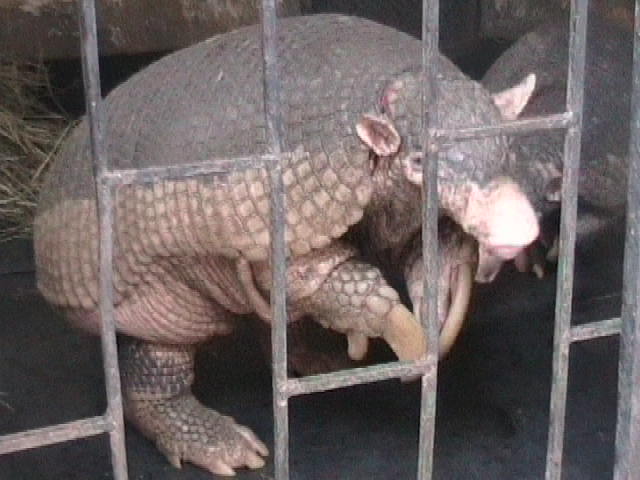- Giant Armadillo
Taxobox
name = Giant Armadillo

image_caption=Captive giant armadillo inColombia
status = VU
status_system = iucn3.1
trend = down
regnum =Animal ia
phylum = Chordata
classis =Mammal ia
ordo =Cingulata
familia =Dasypodidae
subfamilia =Tolypeutinae
genus = "Priodontes"
genus_authority =F. Cuvier , 1825
species = "P. maximus"
binomial = "Priodontes maximus"
binomial_authority = (Kerr, 1792)The Giant Armadillo, also, variously, Tatou, Ocarro, Tatu-canastra or Tatú Carreta, "Priodontes maximus" is the largest living
species ofarmadillo . It was once found widely throughout thetropical forest s of easternSouth America and now ranges throughout varied habitat as far south as northernArgentina . This species is considered vulnerable to extinction.These armadillos typically weigh around 28 kg (59 lb) when fully grown, but a 32 kg (71 lb) specimen has been weighed in the wild. A typical length is 89 cm (35 in), of which a third to two-fifths is likely to be accounted for by the tail.
The Giant Armadillo prefers
termite s and someant s as prey, and often consumes the entire population of a termite mound. It has been known to also prey upon larger creatures, sometimes consuming small mammals such asmice andrat s.Fact|date=June 2008The Giant Armadillo was classified as Endangered (EN — A1cd) on the
World Conservation Union 's Red List in 2002, and is listed under Appendix I (threatened with extinction) of theConvention on the International Trade in Endangered Species of Wild Flora and Fauna .At least one zoo park in
Villavicencio ,Colombia -- called "Los Ocarros" -- is dedicated to this animal.See also
*
Glyptodontidae - an extinct family of huge, armadillo-like cingulate mammals.References
* Database entry includes justification for why this species is vulnerable
*MSW3 Gardner|pages=98External links
* Animal Diversity Web: [http://animaldiversity.ummz.umich.edu/site/accounts/information/Priodontes_maximus.html Priodontes maximus: Information]
* [http://sea.unep-wcmc.org/isdb/CITES/Taxonomy/tax-species-result.cfm?Genus=Priodontes&Species=maximus&source=animals "Priodontes maximus"] from the UNEP World Conservation Monitoring Centre.
* [http://www.msu.edu/~nixonjos/armadillo/priodontes.html Genus "Priodontes"]
Wikimedia Foundation. 2010.
